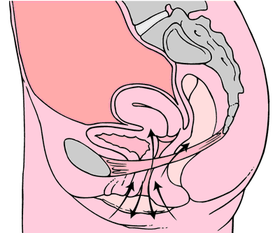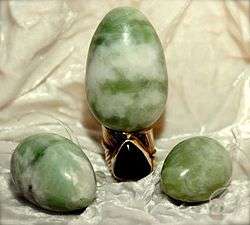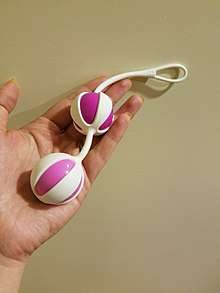Kegel exercise
| Kegel exercise | |
|---|---|
 Kegel exercises diagram | |
| Pronunciation | Kegel /ˈkeɪɡəl/ |
| Synonyms | Pelvic floor exercise, pelvic muscle exercise |
Kegel exercise, also known as pelvic floor exercise, consists of repeatedly contracting and relaxing the muscles that form part of the pelvic floor, now sometimes colloquially referred to as the "Kegel muscles". The exercise can be performed multiple times each day, for several minutes at a time, for one to three months, to begin to have an effect.
Kegel exercises can make the pelvic floor muscles stronger. These are the muscles that hold up the bladder and help keep it from leaking.[1][2] Exercises are usually done to reduce urinary stress incontinence[2] (especially after childbirth) and reduce premature ejaculation in men.[3]
Several tools exist to help with these exercises, although various studies debate the relative effectiveness of different tools versus traditional exercises.[4] They were first described in 1948 by American gynecologist Arnold Kegel.
Health effects
Factors such as pregnancy, childbirth, aging, being overweight, and abdominal surgery such as cesarean section, often result in the weakening of the pelvic muscles.[5] This can be assessed by either digital examination of vaginal pressure or using a Kegel perineometer. Kegel exercises are useful in regaining pelvic floor muscle strength in such cases.
Urinary health
Pelvic floor exercise is the recommended first-line conservative treatment for women with urinary incontinence of the stress, urge, or mixed types.[6] There is tentative evidence that biofeedback may give added benefit when used with pelvic floor muscle training.[7] After a prostatectomy there is no clear evidence that teaching pelvic floor exercises alters the risk of urinary incontinence in men.[8]
Pelvic prolapse
The symptoms of prolapse and its severity can be decreased with pelvic floor exercises.[9][10] Effectiveness can be improved with feedback on how to do the exercises.[11]
Mechanism of action
The aim of Kegel exercises is to improve muscle tone by strengthening the pubococcygeus muscles of the pelvic floor. Kegel is a popular prescribed exercise for pregnant women to prepare the pelvic floor for physiological stresses of the later stages of pregnancy and childbirth. Kegel exercises are said to be good for treating vaginal prolapse[12] and preventing uterine prolapse[13] in women and for treating prostate pain and swelling resulting from benign prostatic hyperplasia (BPH) and prostatitis in men. Kegel exercises may be beneficial in treating urinary incontinence in both men and women.[14] Kegel exercises may also increase sexual gratification, allowing women to complete pompoir and aid in reducing premature ejaculation[3] in men. The many actions performed by Kegel muscles include holding in urine and avoiding defecation. Reproducing this type of muscle action can strengthen the Kegel muscles. The action of slowing or stopping the flow of urine may be used as a test of correct pelvic floor exercise technique.[15][10]
It is now known that the components of levator ani (the pelvic diaphragm), namely pubococcygeus, puborectalis and ileococcygeus, contract and relax as one muscle. Hence, pelvic floor exercises involve the entire levator ani rather than pubococcygeus alone. Pelvic floor exercises may be of benefit in cases of fecal incontinence and pelvic organ prolapse conditions e.g. rectal prolapse.[16]
Pelvic toning devices
Some devices have been marketed to women exercise their pelvic floor muscle and improve the muscle tone of the pubococcygeal or vaginal muscle.

As of 2013 there was no evidence that doing pelvic floor exercise with weights worked better than doing Kegel exercises without weights; there is greater risk with weights, because a foreign object is introduced into the vagina.[17][4]
Inserting foreign objects into the vagina increases the risk of infections and can lead to vaginosis or toxic shock syndrome.[18] Overuse of such kegel exercises, with or without a device, can lead to pelvic pain and pain during sex.[18]
Marketing
During the latter part of the 20th century, a number of medical and pseudo-medical devices were marketed to consumers as improving sex or orgasms, increasing "energy", "balancing hormones", and as having other health or lifestyle benefits. There is no evidence for any of these claims, and many of them are pseudoscience.[18][19][20]
See also
References
- ↑ "Kegel Exercises | NIDDK". National Institute of Diabetes and Digestive and Kidney Diseases. Retrieved 2017-12-02.

- 1 2 "Pelvic floor muscle training exercises: MedlinePlus Medical Encyclopedia". medlineplus.gov. Retrieved 2017-12-02.
- 1 2 La Pera, G; Nicastro, A (1996). "A new treatment for premature ejaculation: the rehabilitation of the pelvic floor". Journal of sex & marital therapy. 22 (1): 22–6. doi:10.1080/00926239608405302. PMID 8699493.
- 1 2 "A randomised controlled trial of the PelvicToner Device in female stress urinary incontinence". BJUI.org. Retrieved 2011-09-02.
- ↑ Services, Department of Health & Human. "Pelvic floor". Retrieved 2018-02-21.
- ↑ Dumoulin C, Hay-Smith J (14 May 2014). "Pelvic floor muscle training versus no treatment, or inactive control treatments, for urinary incontinence in women". Cochrane Database of Systematic Reviews. 2014 (5): CD005654. doi:10.1002/14651858.CD005654.pub3. PMID 24823491.
- ↑ Herderschee R, Hay-Smith EJ, Herbison GP, Roovers JP, Heineman MJ (6 July 2011). "Feedback or biofeedback to augment pelvic floor muscle training for urinary incontinence in women". The Cochrane Database of Systematic Reviews (7): CD009252. doi:10.1002/14651858.CD009252. PMID 21735442.
- ↑ Anderson, Coral A.; Omar, Muhammad Imran; Campbell, Susan E.; Hunter, Kathleen F.; Cody, June D.; Glazener, Cathryn M. A. (2015-01-20). "Conservative management for postprostatectomy urinary incontinence". The Cochrane Database of Systematic Reviews. 1: CD001843. doi:10.1002/14651858.CD001843.pub5. ISSN 1469-493X. PMID 25602133.
- ↑ Hagen S, Stark D (2011). "Conservative prevention and management of pelvic organ prolapse in women". Cochrane Database Syst Rev. 12 (12): CD003882. doi:10.1002/14651858.CD003882.pub4. PMID 22161382.
- 1 2 "Cystocele (Prolapsed Bladder) | NIDDK". National Institute of Diabetes and Digestive and Kidney Diseases. Retrieved 2017-12-02.
- ↑ Herderschee, R; Hay-Smith, EJ; Herbison, GP; Roovers, JP; Heineman, MJ (6 July 2011). "Feedback or biofeedback to augment pelvic floor muscle training for urinary incontinence in women". The Cochrane Database of Systematic Reviews (7): CD009252. doi:10.1002/14651858.CD009252. PMID 21735442.
- ↑ September 2, 2011 (2011-02-09). "Vaginal Prolapse". eMedicineHealth. Retrieved 2011-09-02.
- ↑ "MedlinePlus Medical Encyclopedia: Uterine prolapse". Nlm.nih.gov. 2011-08-29. Retrieved 2011-09-02.
- ↑ "MedlinePlus Medical Encyclopedia: Kegel exercises". Nlm.nih.gov. 2011-08-29. Retrieved 2011-09-02.
- ↑ Kenway, M., and Goh, J. (2009). Inside Out: The Essential Women's Guide to Pelvic Support.
- ↑ Bø, K (2006). "Can pelvic floor muscle training prevent and treat pelvic organ prolapse?". Acta Obstet Gynecol Scand. 85 (3): 263–8. doi:10.1080/00016340500486800. PMID 16553172.
- ↑ Herbison, GP; Dean, N (8 July 2013). "Weighted vaginal cones for urinary incontinence". The Cochrane Database of Systematic Reviews (7): CD002114. doi:10.1002/14651858.CD002114.pub2. PMID 23836411.
- 1 2 3 Gunter, Jen (2017-01-17). "Dear Gwyneth Paltrow, I'm a GYN and your vaginal jade eggs are a bad idea". Dr. Jen Gunter. Retrieved 2017-03-12.
- ↑ Tuteur, Amy (18 December 2008). "Vaginal weight lifting". The Skeptical OB.
- ↑ "No, Gwyneth Paltrow, women should not put jade eggs in their vaginas, gynecologist says". Washington Post. Retrieved 6 February 2017.
